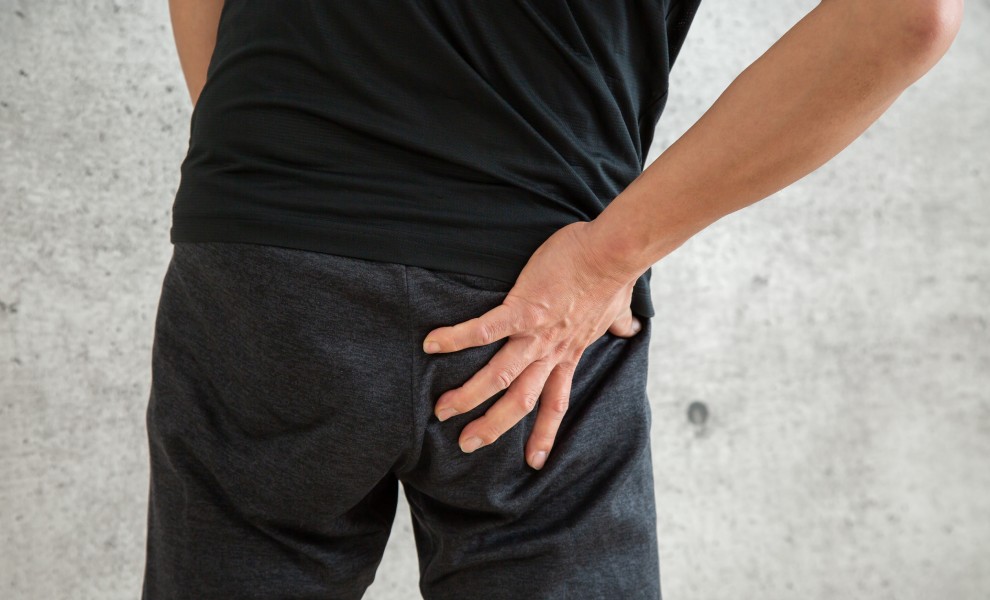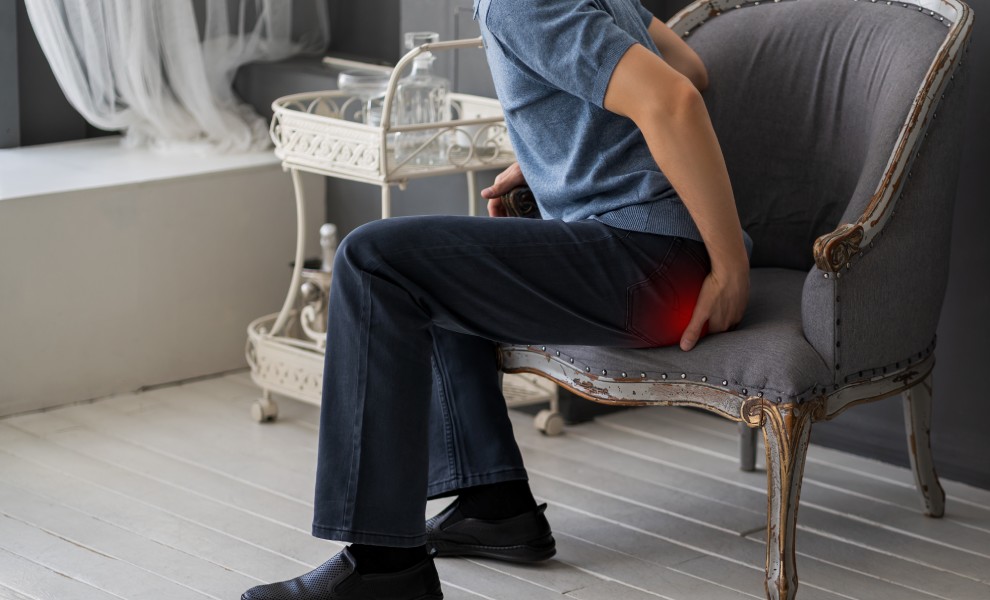Buttock Pain
Buttock pain refers to pain that is felt deep within the buttock muscles, often extending down to the back of the thigh or hip. This type of pain can be severe and may interfere with daily activities such as sitting, walking, or exercising.
Deep buttock pain can have various causes, including muscle strains, joint problems, nerve compression, or inflammation. It can also be a symptom of more serious conditions such as infections or tumours, although these are less common.
It is important to seek medical attention if you are experiencing deep buttock pain, particularly if it is accompanied by other symptoms such as fever, difficulty walking, or numbness or tingling in the legs.
Your healthcare provider can help determine the underlying cause and recommend appropriate treatment.
How Buttock Pain develops
- Buttock pain can develop due to a variety of reasons, including:
- Referred Pain from the Spine
- Overuse or injury: Repetitive strain or trauma to the buttock muscles can cause deep tissue inflammation and pain.
- Poor posture: Sitting or standing in a poor posture for prolonged periods of time can lead to muscle strain and pain in the buttock area.
- Pregnancy: The added weight and pressure of the growing baby during pregnancy can cause strain on the muscles and ligaments of the buttocks, leading to pain.
- Nerve compression: Compression or irritation of the nerves in the lower back, buttock, or leg can cause deep buttock pain. This can be due to conditions such as Sciatica, Piriformis syndrome, or Spinal Stenosis.
- Joint problems: Conditions such as Arthritis, Labral tears, or Impingement of nerves and tendons can cause pain in the hip joint and buttock area.
Rarer Causes of Buttock Pain
Buttock pain can have many possible causes, including:
-
- Piriformis Syndrome: This condition occurs when the piriformis muscle, which runs from the lower spine to the top of the thigh bone, becomes tight or spasms, causing pain in the buttocks.
- Sacroiliac joint dysfunction: The sacroiliac joint connects the sacrum (the triangular bone at the bottom of the spine) to the hip bone. When this joint becomes inflamed or irritated, it can cause deep buttock pain.
- Hamstring Tendinopathy. The Hamstring muscles attach to the posterior part of the pelvic bone. Wear and Tear at the attachment of these muscles can cause Deep Buttock Pain
- Fracture: stress fracture of the ischial tuberosity usually resulting from repetitive microtrauma to the bone.
- Bursitis: Ischial Bursitis (an inflammation of the bursa) can cause buttock pain upon sitting.
Piriformis Syndrome
The Piriformis muscle is a small pear shaped muscle located deep in the buttock region that helps with hip rotation and stability.
In piriformis syndrome, the piriformis muscle becomes tight or inflamed, which can put pressure on the sciatic nerve that runs through or under the muscle.
This pressure can cause pain, tingling, or numbness in the buttocks, as well as radiating pain down the back of the leg and into the foot.
The exact cause of piriformis syndrome is unclear, but it can be due to overuse, repetitive strain, or trauma to the muscle, as well as poor posture or gait.
Other factors that may contribute to the development of piriformis syndrome include muscle imbalances, spinal problems, or sports-related injuries.
Ischial Bursitis
The ischial bursa is a small fluid-filled sac located near the sitting bone (ischial tuberosity), in the buttock area. Its purpose is to reduce friction between the bones, tendons, and muscles in the area.
In ischial bursitis, the bursa becomes inflamed or irritated, often due to repetitive motion or prolonged pressure on the area, such as prolonged sitting or cycling.
This can cause pain in the buttock area when pressure is applied to the area as in when seated, which may be deep, sharp, or dull.
Pain may also radiate down the back of the thigh or leg.
It can be diagnosed through a physical exam and a scan such as an ultrasound or MRI
Hamstring Tendinopathy
Hamstring tendinopathy can cause buttock pain, especially if the hamstring tendon attaching to the pelvis is affected.
The hamstring muscles are a group of three muscles that run down the back of the thigh and attach to the ischial tuberosity, which is the sitting bone in the buttock area.
The tendons of these muscles can become inflamed or degenerated, leading to pain in the area where they attach to the bone.
The pain in the buttock area caused by hamstring tendinopathy can be felt as a deep ache, often aggravated by sitting or activities that activate the hamstrings, such as running, jumping, or climbing stairs.
Pain may also be felt in the back of the thigh, and the affected leg may feel weak or stiff.
Other symptoms of hamstring tendinopathy may include tenderness, swelling, or a tender lump in the affected area.
Stress Fracture of Ischial Tuberosity
A stress fracture of the ischial tuberosity, which is the sitting bone in the buttock area, can cause buttock pain. These are easily missed and often only found after a detailed exam and further scanning
Stress fractures are small fractures in the bone caused by repetitive stress or overuse.
In the case of the ischial tuberosity, stress fractures may be caused by activities that involve repeated or prolonged sitting, such as rowing, cycling, or horse riding.
They can also be due to trauma such as a fall
The pain caused by a stress fracture of the ischial tuberosity may be felt as a deep ache or sharp pain in the buttock area, which is often aggravated by sitting or activities that put pressure on the area. Pain may also be felt when walking, running, or climbing stairs. Other symptoms may include tenderness or swelling in the affected area.
Diagnosis of a stress fracture of the ischial tuberosity may be confirmed through imaging tests, such as an X-ray, CT scan, or MRI.
Treatment typically involves rest, avoiding activities that aggravate the injury, and allowing time for the bone to heal.
In some cases, a brace or crutches may be recommended to help relieve pressure on the affected area.
How to relieve buttock muscle pain
- To relieve buttock muscle pain, you may try the following
- Rest: Resting the affected area can help reduce inflammation and promote healing.
- Ice or heat therapy: Apply ice or heat to the affected area to help reduce inflammation and relieve pain. Ice can be applied for 10-15 minutes at a time, while heat can be applied for 15-20 minutes at a time.
- Massage: In certain cases gentle massage of the affected area can help relieve muscle tension and promote circulation (better to have a diagnosis before beginning this
- Stretching: Gentle stretching can help improve flexibility and relieve muscle tension. Try stretching the affected area for 15-30 seconds at a time and repeat several times a day (Again types of stretches are important, Sciatica/Nerve entrapment should be excluded before you begin these.
- Over-the-counter pain relief: ibuprofen or Paracetamol can help relieve pain and reduce inflammation.
- Physical therapy: A physical therapist can help you develop a personalised exercise program to relieve muscle pain and prevent future injuries after a diagnosis has been established in the form of a clinical examination and possible scan

If your buttock pain persists or worsens, it is important to see a Clinician for an accurate diagnosis and appropriate treatment to avoid misdiagnosis and delays to treatment.
With careful management, this can be managed before the pain becomes a chronic problem

